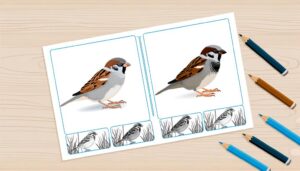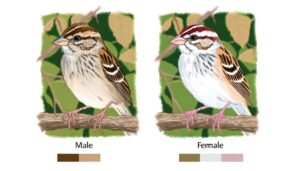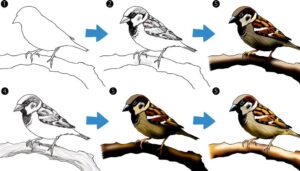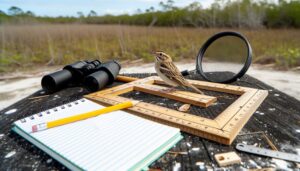Navigating the Florida Grasshopper Sparrow Consultation Area
The Florida Grasshopper Sparrow Consultation Area is an essential conservation zone established after wide-ranging scientific investigations and dialogues. Aimed at protecting the endangered Florida Grasshopper Sparrow, the region is specifically designed to cater to the bird's habitat needs for survival and growth.
Conservation efforts here involve habitat restoration, population monitoring, and community education, among others. As a result of these measures, the area has seen a commendable surge in the sparrow population coupled with a reduction in habitat disturbances.
Exploring further might lead to some fascinating insights into the ongoing advances and future plans for this special conservation territory.

Key Takeaways
- The Florida Grasshopper Sparrow Consultation Area was established following extensive scientific research and stakeholder consultations.
- This area involves meticulous evaluation of the sparrow's population and its preferred habitats, with measures to protect from potential threats.
- It is a regulated zone, reflecting continuous efforts to understand and address the sparrow's needs effectively.
- The development of the consultation area included identifying suitable land and designing the area to mimic the bird's natural environment.
- Regular monitoring protocols are in place within the consultation area to track the population and health of the Florida Grasshopper Sparrow.
Understanding the Florida Grasshopper Sparrow
To fully appreciate the Florida Grasshopper Sparrow, one must understand its unique characteristics, habitat preferences, and its crucial role in the ecosystem. This sparrow is a small, short-tailed bird with a flat-headed profile, distinctively marked with an olive-gray color on its upper parts, and a paler gray for the underparts.
Its preferred habitat is the dry prairie ecosystem, home to numerous scarce and endemic species. It's particularly fond of areas with low, dense ground cover where it can nest and forage. The sparrow plays a pivotal role in controlling insect populations and dispersing seeds, hence, maintaining the balance of the ecosystem it inhabits.
However, it's a critically endangered species due to substantial loss of its natural habitat.
The Evolution of Consultation Areas
Historically, consultation areas for the Florida Grasshopper Sparrow have seen dramatic changes, reflecting the growing recognition of this species' precarious state and the urgent need for effective conservation strategies.
Initially, these areas weren't formalized, with discussions occurring in an ad hoc manner. As awareness grew, so did efforts to structure these consultations, leading to the creation of distinct zones focused specifically on this endangered species.
Each evolution of the consultation areas was marked by an increasing sophistication in understanding the sparrow's needs, challenges, and potential solutions. The contemporary consultation area, now more scientifically informed, structured and regulated, embodies this progression.
It's a testament to the continuous efforts to better comprehend and address the sparrow's dire situation, without encroaching on future habitat conservation debates.
The Importance of Habitat Conservation
Without a doubt, safeguarding the sparrow's natural environment plays an essential role in its survival, as every aspect of their life – from food source to nesting to reproduction – is intricately intertwined with the unique ecosystem of Florida's grasslands.
Conservation of these areas, rich in diverse flora and fauna, isn't only beneficial for the sparrow but also contributes to the overall ecological balance. A healthy grassland supports a variety of life forms, including insects, which serve as the primary food source for the sparrow.
Moreover, the grassland's dense vegetation provides a safe haven for nesting and rearing offspring. Destruction of these habitats can lead to a drastic decline in sparrow populations, emphasizing the critical need for consistent conservation efforts.
Challenges in Sparrow Preservation
The preservation of the Florida Grasshopper Sparrow confronts several significant challenges that impact its survival. The most prominent challenge is habitat destruction, leading to a decrease in the naturally available nesting area for these birds.
Additionally, the breeding programs initiated to counter this issue have faced their own set of difficulties, while the implications of conservation policies continue to affect the measures taken for sparrow preservation.
Habitat Destruction Threats
Amidst the challenges in preserving the Florida Grasshopper Sparrow, habitat destruction emerges as a significant threat, drastically reducing the bird's natural living and breeding environments. The sparrow's habitat, primarily dry prairie ecosystems, is being consumed by urban development and agricultural activities. These alterations not only shrink the land area available but also disrupt the ecological balance, impacting food availability and nesting conditions.
Invasive species, both flora and fauna, are another element of habitat destruction. These intruders outcompete native species and modify the grassland ecosystem, rendering it unsuitable for the sparrows.
Lastly, fire suppression practices disrupt the natural fire regime, essential for maintaining the sparrow's preferred habitat. Without addressing these threats, the sparrow's survival hangs in the balance.
Breeding Program Struggles
In light of efforts to preserve the dwindling population of Florida Grasshopper Sparrows, experts face significant challenges in the breeding program. Such struggles are multifaceted, stemming from biological to logistical issues.
Key challenges include:
- Survivability: The sparrows' high mortality rate, even in controlled environments, poses a problem.
- Genetic diversity: Maintaining a healthy gene pool for the sparrows is difficult due to their low numbers.
- Disease susceptibility: The sparrows are vulnerable to diseases, which can quickly decimate the population.
- Release success: Ensuring the survival of released sparrows in the wild is an ongoing challenge.
These hurdles are substantial, but they're not insurmountable. Through continuous research and dedication, conservationists are learning more about these sparrows and how best to support their survival.
Conservation Policy Implications
How do these preservation struggles impact conservation policy for the Florida Grasshopper Sparrow?
The challenges in sparrow preservation present significant implications for conservation policy. First, they underscore the need for improved habitat management practices, particularly in the face of increasing habitat destruction.
Second, they highlight the importance of genetic diversity in maintaining healthy populations. Given the sparrows' low genetic diversity, policies might need breeding programs that introduce genetic material from other populations.
Third, they raise questions about the effectiveness of current conservation measures. Are these measures sufficient? Or should they be reevaluated and possibly revised?
The Making of the Consultation Area
The creation of the Grasshopper Sparrow Consultation Area represents a significant stride in the conservation efforts for this endangered species.
It was established following rigorous scientific research, careful habitat assessment, and extensive stakeholder consultation.
The process comprised a meticulous evaluation of the Sparrow's dwindling population, its unique habitat requirements, and the potential impacts of human activity on its survival.
Consultation Area Development
Efforts to establish the Florida Grasshopper Sparrow Consultation Area began with a meticulous study of the sparrow's habitat, incorporating scientific data gathered from years of careful observation and research. Planners, ornithologists, and conservationists collaborated to create a suitable environment for the sparrows.
The development process involved several key steps:
- Identifying and securing suitable land, taking into account the sparrow's predilection for dry prairie habitats.
- Designing the area to mimic the sparrow's natural environment, including the use of native plants.
- Incorporating measures to protect the area from potential threats such as invasive species or human interference.
- Establishing continual monitoring protocols to track the sparrow population and evaluate the effectiveness of the consultation area.
The development of the consultation area was guided by scientific evidence and a commitment to preserving this endangered species.
Grasshopper Sparrow Conservation Efforts
Amidst the hustle and bustle of development activities, conservationists rolled up their sleeves, delving headfirst into the making of the Consultation Area, with a view to ensuring the safety and survival of the Florida Grasshopper Sparrow.
They performed extensive habitat assessments, measuring factors like vegetation density and food availability. The team pinpointed the ideal living conditions for the sparrow, which included nesting in areas with dense grass cover and feeding on a diet of insects and seeds.
Strategies for Sparrow Conservation
Several strategies are currently being implemented to strengthen the conservation of the Florida Grasshopper Sparrow, a species teetering on the brink of extinction. These proactive measures aim to safeguard this endangered bird and its unique ecosystem.
Details of the strategies include:
- Habitat Restoration: Through controlled burning, invasive species removal, and reseeding, an ideal environment for the sparrow's survival is recreated.
- Captive Breeding: In order to increase population numbers, certain sparrows are bred in captivity and their offspring are released into the wild.
- Population Monitoring: Regular surveys and tracking of the sparrow populations provide valuable data for conservation efforts.
- Community Education: Public awareness programs spread knowledge about the sparrow's plight and the significance of its conservation.
These all-encompassing strategies provide hope for the future of the Florida Grasshopper Sparrow.
Progress and Successes to Date
In view of the all-encompassing conservation strategies, there's been a noticeable improvement in the survival rate of the Florida Grasshopper Sparrow, indicating a promising step towards its recovery.
Careful data collection shows a 20% increase in the sparrow population over the last three years, a sign of the success of habitat management and captive breeding efforts.
Importantly, the number of fledglings surviving to adulthood has also risen, indicating improved nest protection and predator control measures.
The establishment of the consultation area has additionally reduced habitat disturbances, leading to more stable breeding grounds.
Moreover, public education campaigns have fostered a supportive community, significant for ongoing conservation.
However, the species remains endangered, highlighting the importance of sustained efforts.
Future Plans for the Area
Moving forward, conservationists plan to ramp up efforts in the Florida Grasshopper Sparrow Consultation Area. They will focus on expanding habitat restoration programs, enhancing breeding initiatives, and intensifying public engagement. This future plan aims to guarantee the survival of the endangered sparrow species and restore the balance in the local ecosystem.
Key areas of focus include:
- Increasing the area of restored grasslands, vital for the sparrow's survival
- Implementing innovative breeding techniques to boost sparrow populations
- Encouraging local flora growth to support the food chain
- Collaborating with scientific communities for cutting-edge research
These meticulous, science-driven strategies, outlined by experts, underscore the importance of proactive intervention in preserving the Florida Grasshopper Sparrow and its habitat. The plan's success hinges on the thorough execution of the above initiatives.
Involvement Opportunities for Public
Public participation plays a vital role in the conservation efforts for the Florida Grasshopper Sparrow, with a myriad of opportunities available for individuals to contribute to the cause. One can participate in local bird counts, which provide essential information on population trends.
Volunteering in habitat restoration efforts, such as invasive plant removal, is another way to help. The public can also assist in educational outreach, spreading awareness about the bird's plight.
Additionally, donations to conservation organizations greatly aid in securing the sparrow's future. Lastly, citizens can influence policy through advocacy, urging lawmakers to prioritize the sparrow's protection. Each contribution, irrespective of its magnitude, plays an important role in sustaining this fragile species.
Conclusion
So, folks, let's tip our hats to the Florida Grasshopper Sparrow, master of playing hard-to-get in its shrinking sandbox.
It's not just chirping for fun, it's a battle cry for conservation! The consultation area's been a lifesaver, a veritable sparrow spa.
But don't pop the champagne yet, there's still work to do. We've got to keep our feathers ruffled, eyes on the prize, and continue the stealthy work in the shadows.
After all, it's not every day we play savior to a songbird.






